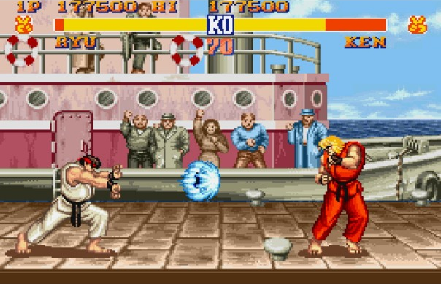vgthought.com
The Rhythm of Street Fighter II
Posted: 2014-03-03 12:27:02
Last edited: 2014-03-03 12:27:07
Originally posted here: Spiderduck Network
Last edited: 2014-03-03 12:27:07
Originally posted here: Spiderduck Network
This was originally published on Empty Wallet Gamer (which later became the Spiderduck Network) on April 9, 2012.
I don't know anything about music theory, and I know even less about how to play Street Fighter II. I try not to be negative in these descriptions, but seriously, make this the last essay you read on this site.
I don't know anything about music theory, and I know even less about how to play Street Fighter II. I try not to be negative in these descriptions, but seriously, make this the last essay you read on this site.
Games discussed:
Street Fighter II
As most of you know, Street Fighter II popularized a certain brand of fighting game combos. In a basic Street Fighter II combo, you start out with some light attacks, throw in a medium attack or two, and finish off with a strong attack. In a successful combo, these moves are performed in succession, one after another, without break.

Here, Ryu attempts to perform a one-hit combo on Ken.
This idea strikes me as particularly musical. Maybe Iím crazy, but Iíd say it resembles a melody built with the diatonic scale.
Donít get me wrong, thereís nothing essentially musical about an Street Fighter II combo. However, they both share similar pacing: they both start out small and gradually build up to a finish. The comparison is interesting to consider.
In a song, the tonic provides the basis for what you hear. A songís key is named after its tonic; for instance, if a songís key is C Major, it will use C as its tonic. The tonic sets the tone.
The tonic of a Street Fighter II combo is your light attack. Your light attacks start a combo and are the easiest hits to string together. Thatís because theyíre fast and donít knock the enemy far back. Because they fill out so much of the combo and set the groundwork for all of your other moves, they make a nice tonic.
A songís dominant, on the other hand, creates instability in response to a tonic. Itís normally used for the crescendo of a melody, providing the most exciting or satisfying moment.
In an Street Fighter II combo, the dominant is your strong attack. This is the height of your combo, the finisher, the real damage-causer. In the same sense that a tonic leads to a dominant, the light attacks build up to a strong attack.
Now, the diatonic scale contains more notes than just the tonic and dominant. Similarly, Street Fighter II contains medium attacks. Any good melody contains more than just a tonic and a dominant, and any good combo will make use of medium hits between the weak and strong ones.
Street Fighter IIís special attacks are often used as bridges; they can be useful in stringing together combos in the way that bridges string together different portions of a song.
The elegance of a thoroughly-considered and well-performed combo can be musical in its own right, Iíd say. Well, maybe thatís going a bit far. But music and combos do share the same basic sense of pacing, at any rate.
comments powered by Disqus
All original content on VG Thought was written by Greg Livingston AKA Golem.